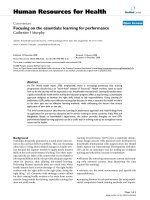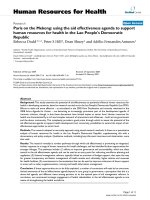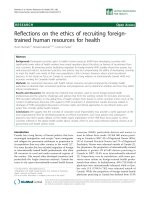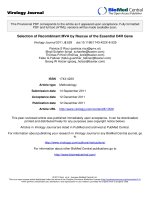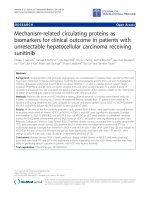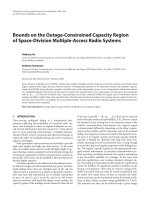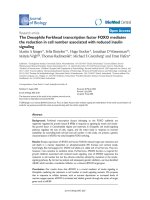Báo cáo sinh học: "Selection on testis size as an indicator of maturity in growing animals. I Direct and correlated responses in growth" pdf
Bạn đang xem bản rút gọn của tài liệu. Xem và tải ngay bản đầy đủ của tài liệu tại đây (841.98 KB, 16 trang )
Original
article
Selection
on
testis
size
as
an
indicator
of
maturity
in
growing
animals.
I
Direct
and
correlated
responses
in
growth
WG
Hill
1
PJ
Marks
JC
Jenkins
1
RB
Land
2
1
Institute
of Animal
Genetics,
University
of Edinburgh,
West
Mains-
Road,
Edinburgh
EH9
3JN;
2
AFRC
Institute
of
Animal
Physiology
and
Genetics
Research,
Edinburgh
Research
Station,
Roslin,
Midlothian
EH25
9PS,
UK
*
(Received
2
October
1989;
accepted
15
February
1990)
Summary -
Selection
was
undertaken
in
mice
to
test
whether
gonad
size,
specifically
testis
weight,
could
be
used
to
indicate
degree
of
maturity
and
produce
genetic
change
in
the
shape
of
the
growth
curve
from
records
on
young
animals
only.
Selection
was
practised
for
11
generations
high
and
low
on
5
wk
male
body
weight
(lines
HX,
LX),
on
5
wk
testis
weight
(XH,
XL)
and
on
indices
with
these
traits
selected
in
the
same
(HH,
LL)
and
in
opposite
(HL,
LH)
directions.
There
were
2
replicates
of
each
selection
line
and
4
unselected
controls.
Divergences
between
high
and
low
lines
within
family
standard
deviation
units
for
5
wk
body
weight
and
testis
weight,
respectively,
were:
HX-LX:
1.8
and
2.3,
XH-XL:
2.2
and
4.2,
HH-LL:
1.9
and
3.4,
and
HL-LH,
2.0
and
-2.7.
There
were
minor
changes
in
shape
of
the
growth
curve
in
the
direction
expected,
with
those
selected
for
high
testis
weight
showing
earlier
maturity.
A
simple
measure,
6
wk
weight/15
wk
weight
(%),
for
entire
males
was:
HX
74.3,
LX
67.3,
XH
71.8,
XL
69.6,
HH
78.1,
LL
72.6,
HL
74.2,
LH
78.5,
averaging
76.1
for
lines
selected
for
high
testis
weight
and
72.1
for
low,
compared
to
74.0
for
controls.
In
castrate
males,
a
similar
pattern
of
changes
in
growth
curve
was
observed
indicating
that
they
were
not
a
consequence
of
testis
derived
hormones.
Mice
selected
for
high
testis
weight
were
leaner
than
those
selected
for
low
testis
weight.
Thus,
growth
curves
changed
due
to
selection
on
testis
weight,
but
it
was
not
established
if
this
is
because
testis
size
is
an
indicator
of
sexual
maturity.
growth
/
maturity
/
testis
/ selection
/
mouse
Résumé -
Sélection
par
la
taille
des
testicules
considérée
comme
un
indicateur
de
la
maturité
des
animaux
en
croissance.
1
Réponse
directe
et
réponse
corrélée
sur
les
caractères
de
croissance.
Une
expérience
de
sélection
a
été
réalisée
chez
la
souris
pour
déterminer
si
la
taille
des
gonades,
en
particulier
la
masse
des
testicules,
pouvait
indiquer
le
degré
de
maturité
et
pouvait
modifier
l’allure
de la
courbe
de
croissance,
à
partir
des
seules
données
recueillies
chez
de
jeunes
animaux.
La
sélection
a
été
conduite
pendant
11
générations,
vers
le
haut
(H)
et
vers
le
bas
(L)
selon
plusieurs
critères:
masse
*
Formerly
AFRC
Animal
Breeding
Research
Organisation
corporelle
chez
le
mâle
à
5 semaines
(lignées
HX,
LX);
masse
testiculaire
à
5 semaines
(XH,
XL);
indices
combinant
ces
deux
caractères,
dans
le
même
sens
(HH,
LL)
ou
en
sens
opposés
(HL,
LH).
Chaque
lignée
sélectionnée
a
été
répétée
deux
fois,
et
.¢
lignées
témoins
non
sélectionnées
ont
été
élevées.
Mesurées
en
unités
d’écart
type
intrafamille,
les
divergences
observées
entre
lignées
haute
et
basse
ont
été
les
suivantes,
respectivement
pour
la
masse
corporelle
et
la
taille
des
testicules:
HX-LX:
1,8
et
2,3;
XH-XL:
2,2
et
4,2;
HH-LL:
1,9
et
3,l;
HL-LH:
2,0
et
-2,7.
On
a
observé
de
petites
différences
de
la
forme
des
courbes
de
croissances
dans
le
sens
attendu,
les
lignées
sélectionnées
pour
une
masse
testiculaire
élevée
montrant
une
maturité
plus
précoce.
Le
rapport
de
la
masse
corporelle
à
6
semaines
sur
celle
à
15
semaines
était
chez
les
mâles
entiers
(en
pourcentage).’
HX:
7/,3;
LX:
67,3;
XH:
71,8;
XL:
69,6;
HH:
78,1;
LL:
72,6;
HL:
7.¢,2;
LH:
78,5;
avec
une
moyenne
de
76,1
chez
les
lignées
sélectionnées
pour
une
masse
testiculaire
élevée,
contre
72,1
chez
celles
sélectionnées
pour
une
masse
testiculaire
faible,
et
74,0
chez
les
lignées
témoins.
L’observation
chez
les
mâles
castrés
de
modifications
similaires
des courbes
de
croissance
indique
qu’elles
ne
sont
pas
dues
aux
hormones
sécrétées
par
les
testicules.
Les
souris
des
lignées
sélectionnées
pour
une
masse
testiculaire
élevée
étaient
plus maigres
que
celles
sélectionnées
pour
une
masse
testiculaire
faible.
Des
modifications
des
courbes
de
croissance
induites
par
la
sélection
sur
la
masse
testiculaire
ont
ainsi
pu
être
observées,
mais
on
n’a
pas
établi
que
c’était
parce
la
masse
testiculaire
est
un
indicateur
spécifique
de
la
maturité
sexuelle.
croissance
/
maturité
/
testicule
/
sélection
/
souris
INTRODUCTION
The
animal
breeders’
aim
is
to
select
animals
of
high
early
growth
but low
mature
size
so as
to
reduce
costs
of
both
the
slaughtered
animal
and
its
dam.
Bone
growth
of
animals
slows
or
terminates
after
puberty
under
the
influence
of
gonadal
hormones,
so
the
object
of
the
experiment
was
to
test
whether
selection
on
body
weight
and
testis
weight
on
the
immature
animal
could
be
used
to
influence
both
early
gains
and
mature
weights.
This
follows
results
in
sheep,
where
selection
on
testis
weight
of
rams
with
phenotypic
correction
for
body
weight
led
to
correlated
changes
in
mature
weights
in
their
female
relatives,
high
testis
weight
being
associated
with
low
body
weight,
and
vice
versa
(Land
et
al,
1980;
Lee
and
Land,
1985;
Haley
et
al,
1989
(submitted);
Lee
and
Haley,
1990).
The
present
approach
differs
from
the
more
direct
method
of
selecting
directly
on
weight
at
different
ages
which
has
been
applied
with
varying
success
in
different
species.
Substantial
bending
of
the
growth
curve
has
been
achieved
in
both
turkeys
(Abplanalp
et
al,
1963)
and
chickens
(Ricard,
1975).
In
mice,
bending
has
been
effected,
but
to
a
lesser
extent
than
in
poultry,
by
McCarthy
and
Doolittle
(1977),
who
selected
on
5
and
10
wk
weight
with
the
objective,
inter
alia,
of
increasing
5
and
holding
10
wk
weight
constant,
by
Wilson
(1973)
who
selected
on
the
ratio
of
3-6
wk
gain
to
3-9
wk
gain,
and
by
von
Butler
et
al
(1980,
1986)
using
3-5
wk
gain
and
8
wk
weight.
These
schemes,
however,
require
selection
decisions
to
be
deferred
until
animals
approach
their
mature
weight
which
is
after
the
usual
age
of
slaughter
and
often
after
the
age
of
first
mating,
when
culling
decisions
have
to
be
made
in
both
mice
and
domestic
livestock.
In
the
present
experiment,
mice
were
selected
high
and
low
for
body
and
testis
weight
on
either
trait
alone
or
on
indices
of
the
2
traits
in
either
the
same
or
the
opposite
direction,
so
as
to
produce
a
range
of
lines.
Subsequently,
body
weights
were
recorded
at
a
series
of
ages
to
assess
the
efficacy
of
the
selection.
As
testis
size
may
also
be
an
indicator
of
ovulation
rate
and
litter
size
(Land
1973),
records
of
reproductive
performance
were
kept
and
will
be
reported
in
a
subsequent
paper
(Hill
et
al,
1990).
Further
details
of
the
experiment
are
reported
in
PhD
theses
by
Jenkins
(n6e
Williams,
1984)
and
Marks
(1988).
MATERIAL
AND
METHODS
Mouse
stocks
and
housing
The
mice
for
generation
0
of
this
experiment
were
crosses
at
generation
3
or
4
between
pairs
of
the
unselected
control
lines
of
the
G
strain
established
from
a
3-way
cross
of
2
inbred
and
1
outbred
strain
(Sharp
et
al,
1984).
Four
separate
sets
of
crosses
were
made
to
establish
the
different
foundation
groups.
The
mouse
house
was
maintained
at
21
f
1°
C,
RH
30-40%,
with
water
and
BP’s
rat
and
mouse
No
1
expanded
maintenance
diet
provided
ad
libitum.
Selection
lines
Twenty
lines
were
established
as
shown
in
table
I,
with
2
replicates
of
each
of
8
selected
lines
and
4
replicates
of
the
unselected
controls.
The
lines
were
managed
as
4
contemporary
groups
spaced
at
3
wk
intervals,
each
group
comprising
4
selected
lines
(which
were
either
the
4
single
trait
lines
or
the
4
index
lines)
and
1
control.
Mice
were
mated
at
approximately
9
wk
of
age.
Eight
pair
matings
per
line
were
made
each
generation,
using
the
maximum
avoidance
scheme
of
Falconer
(1973),
together
with 4
reserve
matings
which
were
only
used
if
necessary.
At
birth,
litter
size
was
adjusted
to
between
6
and
10
young
per
litter
by
adding
or
removing
young
so
as
to
reduce
associated
effects
on
growth.
Within
full
sib
family
selection
of
males
was
practised,
while
females
were
taken
at
random
within
families,
as
were
males
in
the
controls.
The
selection
phase
of
the
experiment
was
continued
for
12
generations,
but
no
selection
was
practised
in
generation
7.
A
preliminary
study
showed
that
5
wk
of
age
was
an
appropriate
age
for
selection.
Both
body
and
testis
are
then
growing
rapidly
and
there
is
a
high
(0.99)
correlation
of
right
and
left
testis
weight
to
allow
hemicastration.
The
coefficients
of
variation
of
body
weight
and
testis
weight
were
then
0.17
and
0.26
respectively
and
their
phenotypic
correlation
was
0.50.
Body
weight
at
5
wk
was
recorded
on
all
males.
Testis
weight
at
5
wk
was
recorded
every
generation
in
lines
selected
on
testis
weight,
but
not
every
generation
in
the
others
(ie
HX, LX
and
CC).
To
do
this,
mice
were
anaesthetised
by
Sagatal
and
hemicastrated,
and
1
testis
was
excised
and
weighed.
The
indices
used
were
7 == ± t!/o-! ± T/o-r = ! 0.54 tV ± 0.112 T
where
W
and
T
denote
body
weight
(g)
and
testis
weight
(mg);
and
Uw
and
er
r
denote
their
within
family
phenotypic
standard
deviations
in
generation
0,
estimated
at
1.82
g
and
8.9
mg
respectively.
In
line
HL,
for
example,
mice
were
selected
for
high
values
of
I =
0.54
W —
0.112
T
each
generation.
Data
recorded
Analyses
of
growth
curves
were
made
at
generations
7
and
13,
after
6
and
11
generations
of
selection,
respectively.
At
generation
13,
litters
were
standardized
to
7
young
at
birth,
and
at
19
d
half
the
male
mice
were
castrated
and
dummy
operations
were
undertaken
on
the
rest.
Eight
entire
and
8
castrated
mice
of
each
line
were
weighed,
at
least
weekly
from
weaning
at
3
wk
until
they
were
17
wk
old.
Food
intake
was
recorded
at
generation
13
on
the
same
mice,
who
were
caged
in
pairs
and
fed
ad
libitum.
Gonadal
fat
pads
and
hind limb
fat
pads
were
dissected
on
11
wk
old
entire
males
of
generation
11,
and
chemical
analysis
of
the
whole
minced
carcass
was
undertaken
on
the
mice
of
generation
13.
Statistical
analysis
The
experiment
was
basically
a
partial
block
design,
with
each
block
comprising
5
lines,
each
line
replicated
over
2
blocks.
Apart
from
the block
(group)
effects
which
were
taken
as
fixed,
there
were
2
other
sources
of
error
associated
with
a
line
mean:
genetic
drift
accumulated
over
the
selection
and
error
due
to
recording
limited
numbers.
This
combined
error
variance
was
estimated
as
the
interaction
variance
between
selection
line
and
replicate.
Thus,
the
model
used
for
observations
taken
only
on
males
was
where:
Yg
hij
is
an
observation
on
individual j
in
replicate
h
of
line
i within
the
type
of
selection
g;
u
is
the
overall
mean;
Tg
is
the
effect
of
type
of
selection
(g
=
1
for
single
trait, g
=
2
for
index;
Rg
h
(h
=
1, 2)
is
the
effect
of
the
hth
replicate
nested
within
the
gth
type
of
selection;
Lg
i
(i
=
1, , 5)
is
the
effect
of
the
line
nested within
type
of
selection;
RL
9hi
is
the
replicate
x
line
within
type
interaction,
which
was
interpreted
as
the
drift
effect
and
was
the
predominant
error
used
in
tests,
although
with
only
8
df;
and
e9hz!
is
the
remainder,
which
in
some
analyses
was
partitioned
to
include
a
litter
effect.
RESULTS
‘
Responses
in
5
week
body
weight
and
testis
weight
Generation
means
for
body
weight
and
testis
weight
of
5
wk
old
males
are
shown
in
figures
1-5.
For
clarity,
results
for
pooled
replicates
are
shown
in
the
graphs,
but
in
table
II,
differences
between
pairs
of
selected
lines
at
the
end
of
selection
(means
of
generations
10,
11
and
12)
are
shown
for
each
replicate.
In
the
single
trait
lines
there
were
direct
responses
(as
divergence
between
high
and
low
lines)
of
the order
of
2
sd
(within
family
standard
deviations)
for
body
weight
and
4
sd
for
testis
weight,
and
similar
positive
correlated
responses
of
about
2
sd
in
testis
weight
and
body
weight
respectively.
Thus,
there
were
substantial
positive
correlated
responses
in
index
1,
where
body
weight
and
testis
weight
have
the
same
sign,
and
negative
correlated
responses
in
index
2,
albeit
very
small
in
the
body
weight
lines.
There
was,
however,
substantial
variation
between
replicates
(table
II),
and,
although
selection
differentials
were
similar
in
high
and
low
lines,
some
asymmetry
of
response
(figs
1-5).
The
replicate
lines
comprised
only
8
mating
pairs
and
so
between
replicate
and
direction,
variation
would
be
expected
from
genetic
sampling.
The
analyses
have
therefore,
to
minimise
their
number,
been
based
on
divergence
between
high
and
low
lines.
There
were
responses
of
the
same
order
in
the
index
1
lines,
ie
about
3
sd
in
the
index
itself,
with
positive
correlated
responses
of
2
and
over
3
sd
in
body
weight
and
testis
weight
respectively,
and
thus,
since
testis
weight
had
changed
relatively
more,
a
negative
correlated
response
was
seen
in
index
2.
Although
the
results
of
the
single
trait
selection
indicate
a
positive
genetic
correlation
between
the
traits,
with
index
2
there
was
a
substantial
direct
response
of
4
sd
in
the
index
and
correlated
responses
of
the
order
of
2
sd
of
increasing
body
weight
and
decreasing
testis
weight.
Estimates
of
realized
heritability
from
within
family
selection
(h!)
obtained
from
regression
of
divergence
of
response
( eg
HX-LX)
on
cumulative
within
family
section
differential
each
generation
are
given
in
table
III.
Using
the
intra-class
correlation
estimate
(t)
from
the
base
population,
estimates
of
heritability
were
obtained
as
h2
=
2(1-
t)hw
(Falconer,
1989).
Both
hw
and h
2
estimates
were
higher
for
testis
weight
and
index
2,
where
antagonistic
selection
was
practised,
than
for
body
weight
and
index
1.
Heritability
estimates
were
lower
than
previously
obtained
for
body
weight
in
this
population
(Sharp
et
al,
1984)
and
testis
weight
on
a
different
population
(Islam
et
al,
1976)
at
later
ages,
10
and
11
wk
respectively.
From
the
pairs
of
single
trait
selection
lines
an
estimate
of
genetic
correlation
is
readily
obtained
as
[(C
TCw
)/(R
wRT
)J
l/2
where,
for
example,
Rw
,C
T
denote
the
direct
response
in
body
weight
and
correlated
response
in
testis
weight
from
selection
on
body
weight
(Falconer, 1989).
From
table
II,
the
estimates
of
correlation
are
0.85,0.49
and
0.80
from
replicates
1,
2
and
pooled,
respectively.
An
estimate
of
the
genetic
correlation
from
the
index
lines
can
also
be
obtained,
and
the
method
of
calculation
is
given
in
the
Appendix.
This
estimate
was
0.17
for
replicates
pooled.
It
is
clear
that
the
index
selection
was
more
effective
in
producing
divergence
of
the
traits
in
opposite
directions,
ie
high
body
weight
and
low
testis
weight,
than
would
be
expected
from
the
single
trait
lines.
A
further
explanation
of
the
higher
heritability
of
index
2
than
of
index
1
would
be
if
the
environmental
correlation
were
much
higher
than
the
genetic
correlation.
Analysis
of
growth
The
selected
lines
did
not
differ
greatly
from
each
other
or
from
the
controls
in
the
general
shape
of
their
growth
curves
at
generation
13.
There
were
however
some
clear,
but
small,
differences
and
more
detailed
analyses
are
necessary
to
demonstrate
these.
Therefore,
in
order
to
show
the
differences,
mean
weights
of
males
of
the
selected
lines
are
given
in
figures
6
and
7 for
entire
and
castrate
males,
respectively,
as
a
percentage
of
the
weights
of
the
corresponding
controls
at
the
same
age.
The
control
means
are
given
in
table
IV.
For
example,
both
the
entire
and
castrate
males
of
the
LL
index
line
are
about
10%
smaller
than
those
of
its
control
at
21
d,
but
only
2%
smaller
at
119
d;
whereas
those
of
the
LH
line
are
also
smaller
than
the
controls,
but
relatively
less
so
at
21
than
119
d.
Even
at
17
wk
when
recording
ceased,
mice
were
still
increasing
in
weight,
presumably
largely
due
to
fat
deposition.
The
line
differences
were
however
generally
well
established
by
that
time.
An
alternative
to
expressing
body
weights
of
1
line
as
a
ratio
of
those
in
another
is
to
use
logarithms,
and
particularly
natural
logs
because
when
ratios
y/x)
are
near
unity,
y/x -1 ;zt; In y -in x.
Some
contrasts
between
relevant
pairs
of
lines
are
given
in
table
IV
(scaled
up
x
100
to
remove
leading
decimal
zeros),
and
some
data
are
included
from
the
study
of
body
weight
taken
at
generation
7,
midway
through
the
experiment.
Apart
from
6
wk
(strictly
41
d)
when
LX
mice
were
atypically
small,
the
divergence
in
body
weight
between
lines
HX
and
LX,
selected
for
body
weight,
was
similar
at
different
ages
in
the
entire
males,
but
tended
to
increase
in
the
castrates.
The
divergence
in
body
weight
between
XH
and
XL,
the
testis
weight
selected
lines,
consistently
decreased
with
age,
as
was
the
case
between
the
index
lines
HH
and
LL,
most
notably
at
generation
13;
these
results
could
be
expected
if
high
testis
weight
lines
matured
earlier.
In
contrast,
the
divergence
between
the
other
index
lines,
HL
and
LH,
remained
more
constant,
tending
to
increase
with
age.
Because
statistical
tests
were
made
against
an
error
term
including
drift
as
estimated
from
differences
between
replicates
with
8
degrees
of
freedom,
only
a
small
number
of
comparisons
of
weights
were
significant.
Relative
maturity
was
computed
as
the
ratio
of
body
weight
at
6
wk
to
that
at
15
wk
for
data
from
both
generations
7
and
13.
(Records
ceased
at
15
w
in
generation
7.
In
generation
13,
records
at
41
and
107
d
were
used).
At
6
wk
the
mice
had
achieved
about
70%
of
their
15-wk
weight
(table
V).
The
lines
selected
for
high
testis
weight,
ie
XH, HH
and
LH,
were
all
relatively
earlier
maturing
than
the
corresponding
lines
selected
for
low
testis
weight,
ie
XL, LL
and
HL,
the
difference
being
about
4%
on
average.
Analyses
of
the
records
on
food
intake
taken
in
generation
13
showed
that
the
responses
in
gain
were
generally
accompanied
by
similar
proportional
changes
in
food
intake,
so
there
were
only
trivial
differences
between
the
lines
in
food
conversion
efficiency
(results
not
shown).
Body
composition
Body
composition
was
assessed
from
the
ratio
of
fat
pad
weights
(gonadal
plus
hind
limb
depots)
to
body
weight
on
entire
males
of
11
wk
of
age
in
generation
10,
and
from
total
chemical
fat
as
a
proportion
of
(wet)
body
weight
on
entire
and
castrate
males
of
5
and
17
wk
at
generation
13
(table
VI).
The
lines
differed
little
in
fat
content
at
5
wk.
At
later
ages
there
was
no
very
consistent
pattern
among
those
selected
on
body
weight,
but
the
lines
selected
for
high
testis
weight
were,
on
average,
leaner
than
those
selected
for
low
testis
weight,
by
about
4%
in
both
entire
and
castrate
males
at
17
wk
of
age.
DISCUSSION
AND
CONCLUSION
The
objective
of
this
experiment
was
to
check
the
hypothesis
which
arose
from
the
experiment
with
sheep
(Land
et
al,
1980)
that
the
pattern
of
growth
could
be
altered
by
using
a
measure
of
maturity
such
as
testis
size
on
immature
animals.
Undoubtedly
such
a
change
was
effected,
perhaps
seen
most
clearly
by
the
ratio
of
6-15
wks
in
table
V
for
the
mean
comparisons
of
maturity
of
high
and
low
testis
weight
lines,
which
differed
by
about
4%
around
a
mean
of
70%.
Nevertheless,
the
results
were
not
&dquo;spectacular&dquo;:
they
are
not
clearly
seen
in
simple
plots
of
body
weight
against
age,
so
the
derived
results
shown
in
figures
6-7
were
necessary.
One
of
the
more
striking
aspects
of
the
growth
curve
analyses
is
that
very
similar
changes
were
effected
in
both
entire
and
castrated
males
(see
table
V),
and
analyses
(Williams,
1984,
not
tabulated)
at
generation
7
yielded
similar
results
for
females
as
for
males.
This
implies
that
the
presence
of
the
testis
after
19
d,
the
age
of
castration
at
generation
13,
and
circulating
testosterone
are
not
required
for
the
growth
curves
to
change.
Estimates
of
testosterone
levels
were
made
on
5
and
10-wk-old
mice
by
the
method
of
radioimmune
assay
of
Webb
et
al
(1985).
Differences
between
lines
were,
however,
small
compared
to
error
from
natural
and
assay
variation,
for
correlations
of
line
means
on
successive
samplings
were
low
(<
0.5),
and
no
clear
differences
were
found
(results
not
shown).
In
addition,
age
at
sexual
maturity
of
males
was
assessed
in
replicate
1
(there
was
not
time
to
repeat
in
replicate
2)
by
caging
young
males
each
with
several
sexually
mature
females,
and
recording
the
day
of
first
copulatory
plug.
The
control
mean
was
43.5
d,
and
the
contrasts
were
HX-LX
=
-2.0,
XH-XL
=
4.4,
HH-LL
=
-1.2,
HL-LH
=
4.7,
each
with
SE
of
1.1
including
only
within
replicate
error.
In
summary,
the
mean
for
high
testis
weight
lines
was
0.5
d
less
than
for
low
testis
weight
lines,
a
trivial
difference
(a
few
mice
did
not
plug
by
49
d,
when
recording
ceased,
but
accounting
for
them
would
not
influence
this
conclusion).
It
is
therefore
unclear
from
this
experiment
that
the
change
in
testis
weight
induced
changes
in
growth
rate
as
a
specific
indicator
of
sexual
maturity
or
directly
through
its
hormonal
action.
Alternatively,
testis
weight
in
relation
to
body
weight
might
simply
be
an
indicator
of
allometric
growth
of
internal
organs,
and
that
high
ratios
of
weights
of
several
organs
to
body
weight
are
an
indicator
of
approaching
maturity.
In
the
experiment
with
sheep
(Land
et
al,
1980),
the
selection
criterion
was
testis
weight
averaged
over
3
ages,
6,
10
and
14
wk,
adjusted
by
phenotypic
regression
on
body
weight
at
these
ages
(Haley
et
al,
1989).
Thus
they
were,
in
effect,
selected
on
an
index
of
high
testis
weight
and
low
body
weight
at
these
ages
and
the
changes
in
body
weight
could
largely
be
due
to
selection
on
body
weight.
Haley
et
al
(1990)
calculate
however,
that
the
genetic
correlation
between
their
selection
criterion
in
males
and
body
weight
in
females
became
increasingly
negative
with
successive
years
of
age
of
the
female,
whereas
simple
negative
selection
on
body
weight
might
be
expected
to
give
a
different
trend.
Correlated
responses
in
reproductive
performance
are
described
in
a
subsequent
paper
(Hill
et
al,
1990),
but
these
are
relevant
to
the
discussion
of
what
influences
mature
size.
Briefly,
positive
correlated
responses
in
litter
size
were
obtained
with
selection
on
body
weight
alone,
testis
weight
alone,
and
on
the
index
of
the
traits
in
the
same
direction
(HH-LL),
but
not
when
selected
in
opposite
directions
(HL-LH).
The
analyses
undertaken
on
those
results
indicate
that
selection
on
testis
weight
influenced
litter
size,
even
after
correction
for
body
weight,
in
accordance
with
the
results
of
Eisen
and
Johnson
(1981)
and
suggesting
that
testis
size
is
indeed
an
indicator
of
development
in
some
specific
way,
as
Land
(1973)
proposed.
From
the
results
of
this
experiment
it
is
not
possible
to
directly
compare
the
accuracy
of
selection
including
records
on
testis
weight
of
immature
animals
to
that
including
body
weight
on
mature
animals,
without
estimates
of
genetic
variances
and
covariances
of
weights
except
at
5
wks.
If
the
intention
were
to
increase
an
early
weight
and
hold
a
later
weight
constant,
the
response
would
then
be
a
little
less
than
(1-rG)
1/z
of
that
with
selection
for
the
early
weight
alone,
where
rG
is
the
genetic
correlation.
For
5
and
10
wk
body
weight,
Hayes
and
McCarthy
(1976)
obtained
rG
=
0.8,
for
which
(1 —
T
&)
1/2
=
0.6.
Nevertheless,
lines
selected
on
testis
weight
and
on
the
indices
of
5
wk
body
weight
and
testis
weight
gave
similar
responses
in
5
wk
body
weight
as
did
the
lines
selected
solely
for
that
trait
and
lower
but
not
zero
responses
at
later
ages.
Five-wk
body
weight
had
a
rather
low
heritability,
both
to
within
family
selection
and
also
when
converted
to
mass
selection,
substantially
lower
than
for
testis
weight;
therefore
testis
weight
was
a
better
predictor
of
body
weight
than
vice
versa.
This
may
not
apply
to
other
species.
The
index
of
practical
interest,
ie
increasing
body
weight
and
testis
weight
(HH),
similarly
had
a
low
heritability,
particularly
for
mass
selection
because
the
intra-class
correlation
of
sibs
was
high.
Furthermore,
there
were
large
differences
between
replicates,
particularly
in
the
correlated
responses
of
the
index
lines
and
apparent
discrepancies
between
genetic
correlations
of
body
weight
and
testis
weight
among
the
sets
of
lines.
Whilst
there
was
reasonably
good
evidence
to
suggest
that
mature
weights
were
reduced
by
selection
on
testis
weight
relative
to
body
weight,
indicating
that
such
animals
matured
earlier,
the
fairly
clear
observation
that
they
were
also
leaner
was
rather
surprising
because,
in
farm
animals,
early
maturity
is
usually
associated
with
higher
degrees
of
fatness
when
comparisons
are
made
at
constant
age.
There
is
no
evidence
that
the
high
testis
weight
selection
led
to
any
restriction
of
appetite
which
might
have
effected
this;
nor
is
there
any
obvious
mechanism.
In
conclusion
selection
on
testis
weight
led
to
some
changes
in
the
shape
of
the
growth
curve.
That
these
were
not
marked
is
not
surprising
in
view
of
the
high
correlation
between
weights
at
different
ages.
At
this
stage
we
would
not,
however,
advocate
selection
to
be
practised
on
testis
weight
to
change
degree
of
maturity.
It
tis
likely
to
be
safer
to
select
directly
on
weights
at
different
ages;
and
if
selection
decisions
need
to
be
made
early
in
the
animal’s
life,
records
of older
relatives
such
as
parents
and
uncles
can
be
used.
ACKNOWLEDGMENTS
This
work
was
supported
by
a
grant
from
the
Agricultural
and
Food
Research
Council.
We
are
very
grateful
to
Roberta
Wallace,
Ann
Walker
and
staff
of
the
mouse
house
for
technical
assistance
and
to
Gene
Eisen,
Douglas
Falconer
and
Chris
Haley
for
comments
on
a
draft
of
the
paper.
Roger
Land
initiated
the
experiment
reported
here
and
died
after
lab
work
had
been
completed.
He
is
greatly
missed.
REFERENCES
Abplanalp
H,
Ogasawara
FX,
Asmundson
VS
(1963)
Influence
of
selection
for
body
weight
at
different
ages
on
growth
of
turkeys.
Br
Poult
Sci
4,
71-82
von
Butler
I,
Duda
J,
Anmann
J
(1986)
Effects
of
divergent
and
antagonistic
selection
for
body
weight
on
sexual
maturity
in
female
mice.
Z
TTersuchstierkunde
28,
187-192
von
Butler
I,
Willeke
H,
Pirchner
F
(1980)
Preliminary
results
on
antagonistic
selection
in
mice.
In:
Selection
Experiments
in
Laboratory
and
Domestic
Animals
(Robertson
A,
ed)
Commonwealth
Agricultural
Bureau,
Slough,
114-117
Eisen
EJ,
Johnson
BH
(1981)
Correlated
responses
in
male
reproductive
traits
in
mice
selected
for
litter
size
and
body
weight.
Genetics
99,
513-524
Falconer
DS
(1973)
Replicated
selection
for
body
weight
in
mice.
Genet
Res
22,
291-321
Falconer
DS
(1989)
Introduction
to
Quantitative
Genetics,
3rd
ed
Longman,
Harlow
Haley
CS,
Lec
GJ,
Fordyce
M,
Land
RB
Selection
for
testis
size
adjusted
for
body
weight
in
male
lambs:
Direct
responses
in
males
and
correlated
responses
for
reproduction
in
females.
J
Reprod
Fert
(submitted)
Hayes
JF,
McCarthy
JC
(1976)
The
effects
of
selection
at
different
ages
for
high
and
low
body
weight
on
the
pattern
of
fat
deposition
in
mice.
Genet
Res
27,
.
389-433
Hill
WG,
Marks
PJ,
Jenkins
JC,
Land
RB
(1990)
Selection
on
testis
size
as
an
indicator
of
maturity
in
growing
animals.
II
Correlated
responses
in
reproductive
rate.
Genet
Sel
Evol 22,
247-254
’
Islam
ABMM,
Hill
WG,
Land
RB
(1976)
Ovulation
rate
in
lines
of
mice
selected
for
testis
weight.
Genet
Res
27,
23-32
Land
RB
(1973)
The
expression
of
female
sex
limited
characters
in
the
male.
Nature
241,
208-209
Land
RB,
Carr
WR,
Lee
GJ
(1980)
A
consideration
of
physiological
criteria
of
reproductive
merit
in
sheep.
In:
Selection
Eiperiments
in
Laboratory
and
Do-
mestic
Animals
(Robertson
A,
ed)
Commonwealth
Agricultural
Bureau,
Slough,
147-160
Lee
GJ,
Land
RB
(1985)
Testis
size
and
LH
response
to
LH-RH
as
male
criteria
of
female
reproductive
performance.
In:
Genetics
of
Reproduction
in
Sheep
(Land
RB,
Robinson
DW,
eds)
Butterworths,
London,
333-341
Lee
GJ,
Haley
CS
(1990)
Body
weight
adjusted
testis
size
as
a
selection
criterion
to
improve
production
efficiency
in
sheep. Proc
4th
World
Congr
Genet
Appl
Livest
Prod
(in
press)
McCarthy
JC,
Doolittle
DP
(1977)
Effects
of
selection
for
independent
changes
in
two
highly
correlated
body
weight
traits
of
mice.
Genet
Res
29,
133-145
Marks
PJ
(1988)
Direct
and
correlated
responses
to
selection
to
change
the
shape
of
the
growth
curve
in
mice.
PhD
Thesis,
University
of
Edinburgh
Ricard
FH
(1975)
Essai
de
selection
sur
la
forme
de
la
courbe
de
croissance
chez
le
poulet.
Ann
G6n6t
Sel
Anam
7, 427-443
Sharp
GL,
Hill
WG,
Robertson
A
(1984)
Effects
of
selection
on
growth,
body
composition
and
food
intake
in
mice.
I.
Responses
in
selected
traits.
Genet
Res
43, 75-92
Webb
R,
Baxter
G,
McBride
D,
Nordblom
GD,
Shaw
MKW
(1985)
The
measure-
ment
of
testosterone
and
oestradiol -
17B
using
iodinated
tracers
and
incorpo-
rating
an
affinity
chromatography
extraction
procedure.
J
Steroid
Biocherri
23,
1043-1051
Williams
JC
(1984)
Influence
of
selection
for
body
weight
and
testis
weight
on
the
growth
of
mice.
PhD
Thesis,
University
of
Edinburgh
Wilson
SP
(1973)
Selection
for
ratio
of
body
weight
gains
in
mice.
J
Anim
Sci
37,
1098-1103
APPENDIX
Estimates
of
genetic
correlation
From
the
within-family
heritability
estimates
(h2 )
of
table
III,
the
direct
(R)
and
correlated
(C)
responses
in
table
II
and
the within
family
standard
deviations,
estimates
of
genetic
variances
(V
A
),
genetic
covariances
(Cov
A)
and
genetic
cor-
relations
(r
A)
were
obtained,
where W
=
body
weight
(g)
and
T
=
testis
weight
(mg),
and
the
units
of
the
indices
are
arbitrary.
From
the
single
trait
lines,
V,qyy
=
2(0.
26)(
1.
82
)2
=
1.
72
and
V
AT
=
76
,
and
thus
CovAWT
=
(CT/
Rw)V
AW
=
10.1
or
C
OV,gWT
=
(CW !RT)vAT
=
8.2,
with
a
mean
of
9.1,
corresponding
to
r A
WT
=
0.80,
as
in
the
text.
From
the
index
lines,
V
AIl
=
1.69
and
V
A12
=
1.24
and
thus
COV
AIII2
=
(C
I2/
R
Il)V
AIl
=
-0.52
Or
C
OVAI112
=
(C
Il/
R
I2)V
AI2
=
W
.18,
with
mean
-0.35,
giving
r
AIlI2
=
-0.24.
Predictions
of
index
variances
and
covariances
from
the
single
trait
lines
and
vice
vers
d
can
also
be
made.
Letting
bl
=
0.54
and b
2
= 0.112
be
the
index
weights,
then:
Y
All
=
b2V
AW
+
2bib2
COVAWT
+
b22VAT, VA12
blV
AW -
2b
1b2
COVAWT
+
b2V
AT
and
Cov
AI1I2
=
b1 V
AW -
b’
2V
AT
and
thus,
for
example,
V
AW
=
(V
An
+
V
A12
+
2
COV,q1112)!(4b1)·
Predicting
from
the
single
trait
lines:
V
An
=
2.56, V
Arz
=
0.35,
CO
VAIlI2
=
-0.45
and
r
All12
= 0.48;
and
predicting
from
the
index
lines,
using
the
mean
estimate
of
Cov All
1
2
= -0.35 :
V
AW
=
1.90, V
AT
=
73,
C
OVAWT
=
1.90
corresponding
to
r
AwT
=
0.17,
which
contrasts
with
the
estimate
of
0.80
from
the
single
trait
lines.
